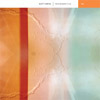Scott Cortez, "Twin Radiant Flux"

As a companion piece to Line's reissue of Lovesliescrushing's CRWTH (Chorus Redux) from earlier this year, guitarist/instrumentalist Scott Cortez has also released a work of guitar ambience from the latter portion of the '90s that is simultaneously reminiscent of the era's sonic fringes, yet sounds just as fresh today as it would have then.
Due to its composition (all processed guitar) and era of initial recording, I can't help but compare Cortez's guitar experimentations with that of Robert Hampson's Main project, who was active at this time as well.Even though the work of both artists would fit comfortably in the isolationist scene from the period, both construct their guitar work into very different frameworks.While Hampson's always sounded as if he was creating microscopic colonies of organisms via layers of digital processing, Cortez's sound feels more atmospheric in the literal sense.The deconstructed tones and hums of guitar are stretched into stratospheric layers of sound, sometimes icy, other times warm and engaging.
Twin Radiant Flux is a single piece broken into three segments, which are indexed into a total of nine tracks.It opens with near silence, with only the most subtle swells of sound that carry an odd, unnatural warmth.It builds in complexity, but then splits apart into even more sparse territory before the sound gets heavier, with dense sounds welling up that actually resemble an electric guitar at times, but only in the loosest of senses.With the heavier sounds comes a more dramatic ambience, bringing a cinematic sense to close the section out.
The second movement begins with ominous sustained notes, occasionally resembling bowed guitar strings but either way bringing a dark, glacial mood along.As the section continues into its second half, it retains the heavy sound briefly, but then retreats, leaving a thinner, but still dramatic motif that brings along rhythmic swells of guitar that trumpet along for most of the duration.
The final portion again opens by retaining the almost recognizable guitar sounds, beginning forcefully and then withdrawing to quiet, pensive textures.The final two sections bring the guitar back, but in the form of shimmering rays of sonic light, pulling out of the cold bleakness of before and into gentle and beautiful skies.By the end the overt guitar is still there, but eventually becomes organ like textures before closing with the same minimal tones that opened the album.
Given Cortez's reliance on Luddite methods:other than guitar most of the output here is from looping pedals and four track cassette recordings, the wide array of sound and emotion conveyed on Twin Radiant Flux is even more impressive.There are a multitude of other artists working in similar fields who don’t come close to the powerful work here with an array of DSP software packages and digital multitracking setups.While the sound is somewhat sparser without the use of LLC vocalist Melissa Arpin-Duimstra’s voice as an instrument, there is a purity here that gives the album its own distinct feel.
samples:
 




